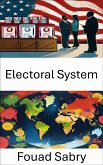Unlock the complexities of electoral systems with Plurality Block Voting, part of the Political Science series by Fouad Sabry. This essential guide offers a comprehensive look at Plurality Block Voting, its mechanisms, impacts, and implications for political representation.
1-Plurality Block Voting-Understand the basics of Plurality Block Voting, its distinctive features, and how it shapes electoral outcomes.
2-Plurality Voting-Explore Plurality Voting's advantages and limitations compared to Plurality Block Voting.
3-Proportional Representation-Examine Proportional Representation and how it contrasts with Plurality Block Voting.
4-Single Transferable Vote-Learn about the transferability in the Single Transferable Vote system and its relevance to voter representation.
5-Single Non-Transferable Vote-Review the impact of Single Non-Transferable Vote on election dynamics compared to Plurality Block Voting.
6-Block Voting-Understand Block Voting and its role in multi-winner elections, as well as its relationship with Plurality Block Voting.
7-First-past-the-post Voting-Examine First-past-the-post Voting's effects on electoral outcomes compared to Plurality Block Voting.
8-Parallel Voting-Explore Parallel Voting and its integration with the Plurality Block Voting system.
9-Electoral District-Understand the concept of Electoral Districts and their influence on Plurality Block Voting.
10-Elections in Mongolia-Analyze the Mongolian electoral system, providing a case study on Plurality Block Voting.
11-List of Alberta General Elections-Review Alberta's general elections to see historical trends related to Plurality Block Voting.
12-1926 Alberta General Election-Investigate the 1926 Alberta general election and its alignment with Plurality Block Voting.
13-General Ticket-Compare the General Ticket system to Plurality Block Voting, focusing on multi-winner elections.
14-Single-Member District-Understand how Single-Member District systems interact with Plurality Block Voting.
15-Multiple Non-Transferable Vote-Analyze how Multiple Non-Transferable Vote contrasts with Plurality Block Voting in voter influence.
16-Semi-Proportional Representation-Investigate Semi-Proportional Representation and its impact on balancing majority rule and fairness.
17-Electoral System-Gain a broad overview of electoral systems, placing Plurality Block Voting in global contexts.
18-Majoritarian Representation-Explore Majoritarian Representation and its influence on electoral outcomes.
19-Mixed Electoral System-Understand how Mixed Electoral Systems combine Plurality Block Voting with other methods.
20-Multiwinner Approval Voting-Analyze Multiwinner Approval Voting and its fairness compared to Plurality Block Voting.
21-Electoral System of Hungary-Examine Hungary's electoral system in comparison to Plurality Block Voting.
Plurality Block Voting offers unmatched insights into how this system shapes voter behavior and electoral strategies. This book is an investment in understanding the intricate dynamics of modern political systems.
1-Plurality Block Voting-Understand the basics of Plurality Block Voting, its distinctive features, and how it shapes electoral outcomes.
2-Plurality Voting-Explore Plurality Voting's advantages and limitations compared to Plurality Block Voting.
3-Proportional Representation-Examine Proportional Representation and how it contrasts with Plurality Block Voting.
4-Single Transferable Vote-Learn about the transferability in the Single Transferable Vote system and its relevance to voter representation.
5-Single Non-Transferable Vote-Review the impact of Single Non-Transferable Vote on election dynamics compared to Plurality Block Voting.
6-Block Voting-Understand Block Voting and its role in multi-winner elections, as well as its relationship with Plurality Block Voting.
7-First-past-the-post Voting-Examine First-past-the-post Voting's effects on electoral outcomes compared to Plurality Block Voting.
8-Parallel Voting-Explore Parallel Voting and its integration with the Plurality Block Voting system.
9-Electoral District-Understand the concept of Electoral Districts and their influence on Plurality Block Voting.
10-Elections in Mongolia-Analyze the Mongolian electoral system, providing a case study on Plurality Block Voting.
11-List of Alberta General Elections-Review Alberta's general elections to see historical trends related to Plurality Block Voting.
12-1926 Alberta General Election-Investigate the 1926 Alberta general election and its alignment with Plurality Block Voting.
13-General Ticket-Compare the General Ticket system to Plurality Block Voting, focusing on multi-winner elections.
14-Single-Member District-Understand how Single-Member District systems interact with Plurality Block Voting.
15-Multiple Non-Transferable Vote-Analyze how Multiple Non-Transferable Vote contrasts with Plurality Block Voting in voter influence.
16-Semi-Proportional Representation-Investigate Semi-Proportional Representation and its impact on balancing majority rule and fairness.
17-Electoral System-Gain a broad overview of electoral systems, placing Plurality Block Voting in global contexts.
18-Majoritarian Representation-Explore Majoritarian Representation and its influence on electoral outcomes.
19-Mixed Electoral System-Understand how Mixed Electoral Systems combine Plurality Block Voting with other methods.
20-Multiwinner Approval Voting-Analyze Multiwinner Approval Voting and its fairness compared to Plurality Block Voting.
21-Electoral System of Hungary-Examine Hungary's electoral system in comparison to Plurality Block Voting.
Plurality Block Voting offers unmatched insights into how this system shapes voter behavior and electoral strategies. This book is an investment in understanding the intricate dynamics of modern political systems.
Dieser Download kann aus rechtlichen Gründen nur mit Rechnungsadresse in A, B, BG, CY, CZ, D, DK, EW, E, FIN, F, GR, H, IRL, I, LT, L, LR, M, NL, PL, P, R, S, SLO, SK ausgeliefert werden.









